NGC 6452, also occasionally referred to as PGC 60876 or GC 5878, is a lenticular galaxy in the constellation Hercules. It was discovered on 2 July 1864 by astronomer Albert Marth.
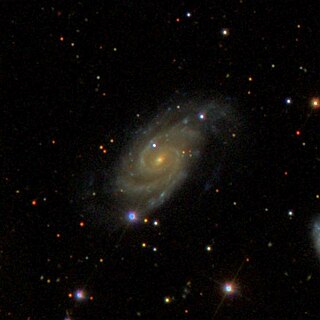
NGC 477 is a spiral galaxy in the constellation Andromeda. It is located approximately 250 million light-years from Earth and was discovered on October 18, 1786 by astronomer William Herschel.
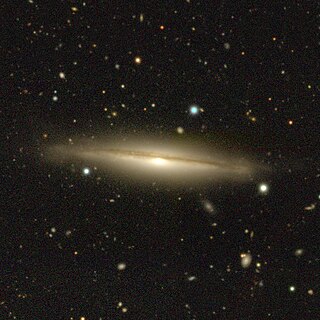
NGC 482 is a spiral galaxy in the constellation Phoenix. It is located approximately 277 million light-years from Earth and was discovered on October 23, 1835 by astronomer John Herschel.
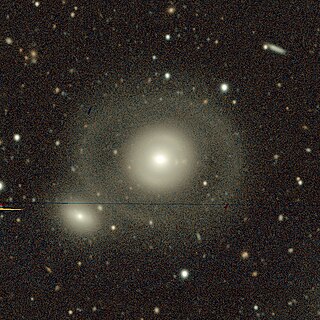
NGC 483 is a spiral galaxy in the constellation Pisces. It is located approximately 192 million light-years from Earth and was discovered on November 11, 1827 by astronomer John Herschel.
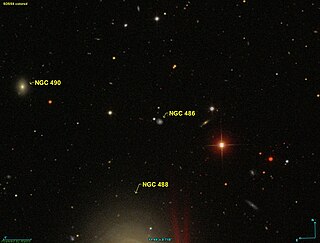
NGC 486, also occasionally referred to as LEDA 1281966 or GC 275, is a spiral galaxy in the constellation Pisces. NGC 486 was discovered on December 6, 1850 by Irish engineer Bindon Blood Stoney.

NGC 490, also occasionally referred to as PGC 4973 or GC 277, is a lenticular galaxy in the constellation Pisces. It is located approximately 85 million light-years from Earth and was discovered on December 6, 1850, by Irish engineer Bindon Blood Stoney. Although John Dreyer, creator of the New General Catalogue, credits the discovery to astronomer William Parsons, he notes that many of his claimed discoveries were made by one of his assistants. In the case of NGC 490, the discovery was made by Bindon Stoney, who discovered it along with NGC 486, NGC 492 and NGC 500 during his observation of NGC 488.

NGC 492, also occasionally referred to as PGC 4976 or GC 280, is a barred spiral galaxy in the constellation Pisces. It is located approximately 590 million light-years from Earth and was discovered on December 6, 1850 by Irish engineer Bindon Blood Stoney. Although John Dreyer, creator of the New General Catalogue, credits the discovery to astronomer William Parsons, 3rd Earl of Rosse, he notes that many of his claimed discoveries were made by one of his assistants. In the case of NGC 492, the discovery was made by Bindon Stoney, who discovered it along with NGC 486, NGC 490 and NGC 500 during his observation of NGC 488 using Lord Rosse's 72" telescope.
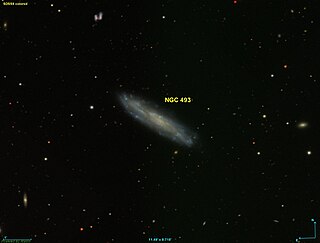
NGC 493, also occasionally referred to as PGC 4979 or GC 281, is a barred spiral galaxy in the constellation Cetus. It is located approximately 90 million light-years from Earth and was discovered on December 20, 1786 by astronomer William Herschel. It was later also observed by his son, John Herschel. John Dreyer, creator of the New General Catalogue, described the galaxy as "very faint, large, much extended 60°" with "a little brighter middle".

NGC 494, also occasionally referred to as PGC 5035 or GC 282, is a barred spiral galaxy in the constellation Pisces. It is located approximately 227 million light-years from Earth and was discovered on 22 November 1827 by astronomer John Herschel. John Dreyer, creator of the New General Catalogue, described the galaxy as "very faint, pretty large, extended, 3 faint stars to south".

NGC 495, also occasionally referred to as PGC 5037, UGC 920 or GC 278, is a barred spiral galaxy in the constellation Pisces. It is located approximately 184 million light-years from the Solar System and was discovered on 12 September 1784 by astronomer William Herschel.

NGC 496, also occasionally referred to as PGC 5037, UGC 927 or GC 288, is a spiral galaxy in the constellation Pisces. It is located approximately 250 million light-years from the Solar System and was discovered on 12 September, 1784 by astronomer William Herschel.

NGC 499, also occasionally referred to as PGC 5060, IC 1686 or GC 289, is a lenticular galaxy in the constellation Pisces. It is located approximately 197 million light-years from the Solar System and was discovered on 12 September, 1784 by astronomer William Herschel.

NGC 5609 is a spiral galaxy located 1.3 billion light-years light-years away from Earth, in the constellation Boötes. It has the largest redshift of any galaxy in the New General Catalogue. Prior to 2023, another spiral galaxy, NGC 1262, had been thought to have a higher redshift. NGC 5609 is the most distant visually observed galaxy in the NGC Catalog and was discovered by astronomer Bindon Blood Stoney on March 1, 1851.

NGC 502, also occasionally referred to as PGC 5034 or UGC 922, is a lenticular galaxy in the constellation Pisces. It is located approximately 113 million light-years from the Solar System and was discovered on 25 September 1862 by German astronomer Heinrich Louis d'Arrest. When the Morphological Catalogue of Galaxies was published between 1962 and 1974, the identifications of NGC 502 and NGC 505 were reversed. In reality, NGC 502 is equal to MGC +01-04-041 and not MCG +01-04-043 as noted in the catalogue.

NGC 503, also occasionally referred to as PGC 5086 or GC 5169, is an elliptical galaxy in the constellation Pisces. It is located approximately 265 million light-years from the Solar System and was discovered on 13 August 1863 by German astronomer Heinrich Louis d'Arrest.

NGC 504, also occasionally referred to as PGC 5084 or UGC 935, is a lenticular galaxy located approximately 189 million light-years from the Solar System in the constellation Pisces. It was discovered on 22 November 1827 by astronomer John Herschel. The object was listed twice in the General Catalogue, precursor of the New General Catalogue, as both GC 291 and GC 292.
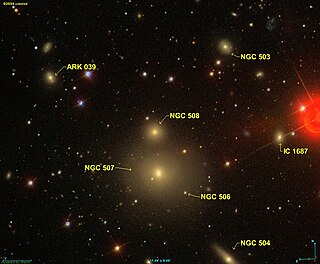
NGC 508, also occasionally referred to as PGC 5099 or UGC 939, is an elliptical galaxy in the constellation Pisces. It is located approximately 247 million light-years from the Solar System and was discovered on 12 September 1784 by British astronomer William Herschel.
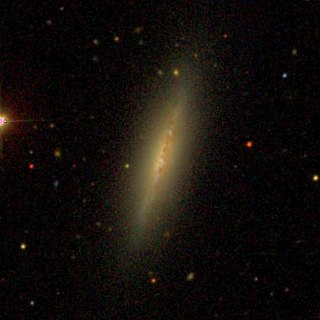
NGC 4544 is an edge-on spiral galaxy located about 52 million light-years away in the constellation Virgo. NGC 4544 was discovered by astronomer Edward Swift on April 27, 1887. NGC 4544 is a member of the Virgo Cluster.

NGC 521, also occasionally referred to as PGC 5190 or UGC 962, is a barred spiral galaxy located approximately 224 million light-years from the Solar System in the constellation Cetus. It was discovered on 8 October 1785 by astronomer William Herschel.
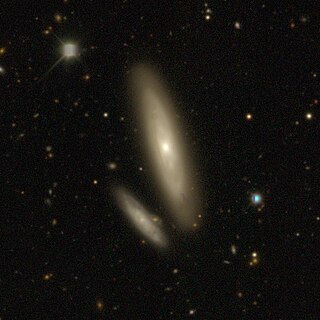
NGC 527, also occasionally referred to as PGC 5128 or PGC 5141, is a lenticular galaxy located approximately 259 million light-years from the Solar System in the constellation Sculptor. It was discovered on 1 September 1834 by astronomer John Herschel.




















